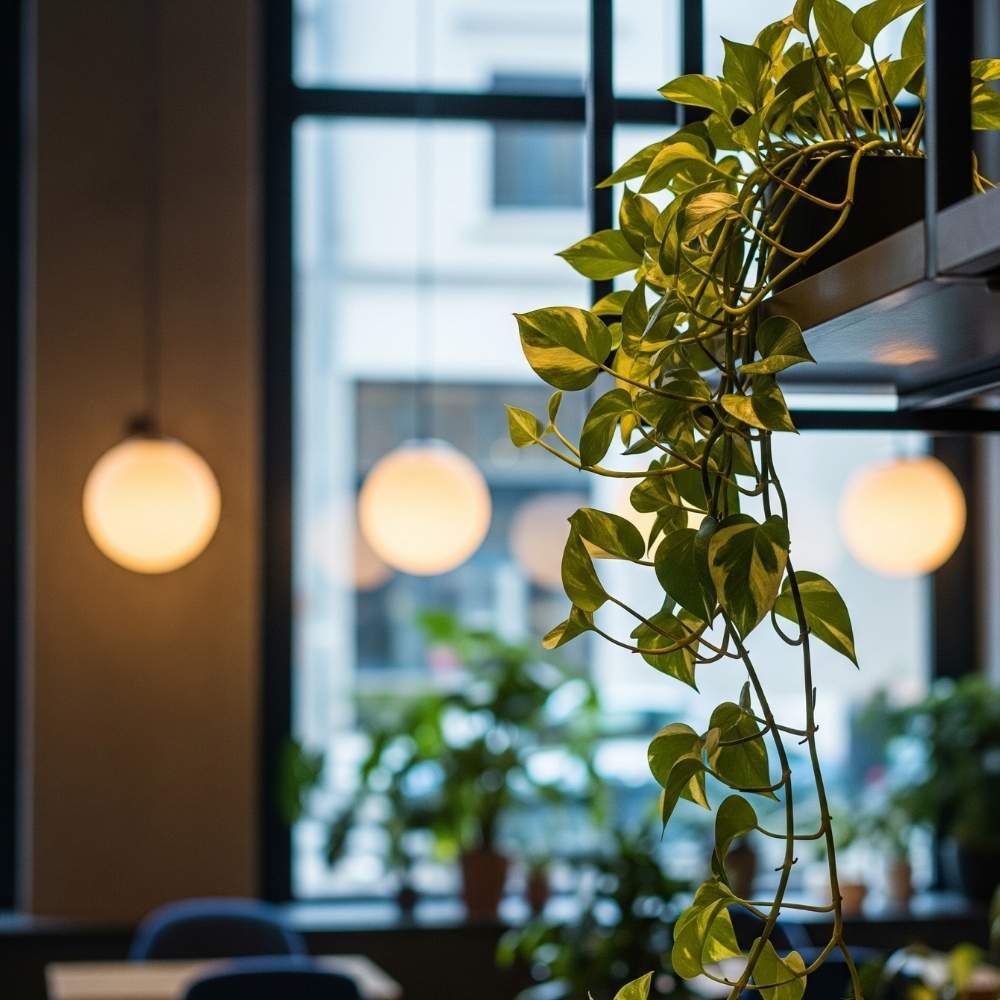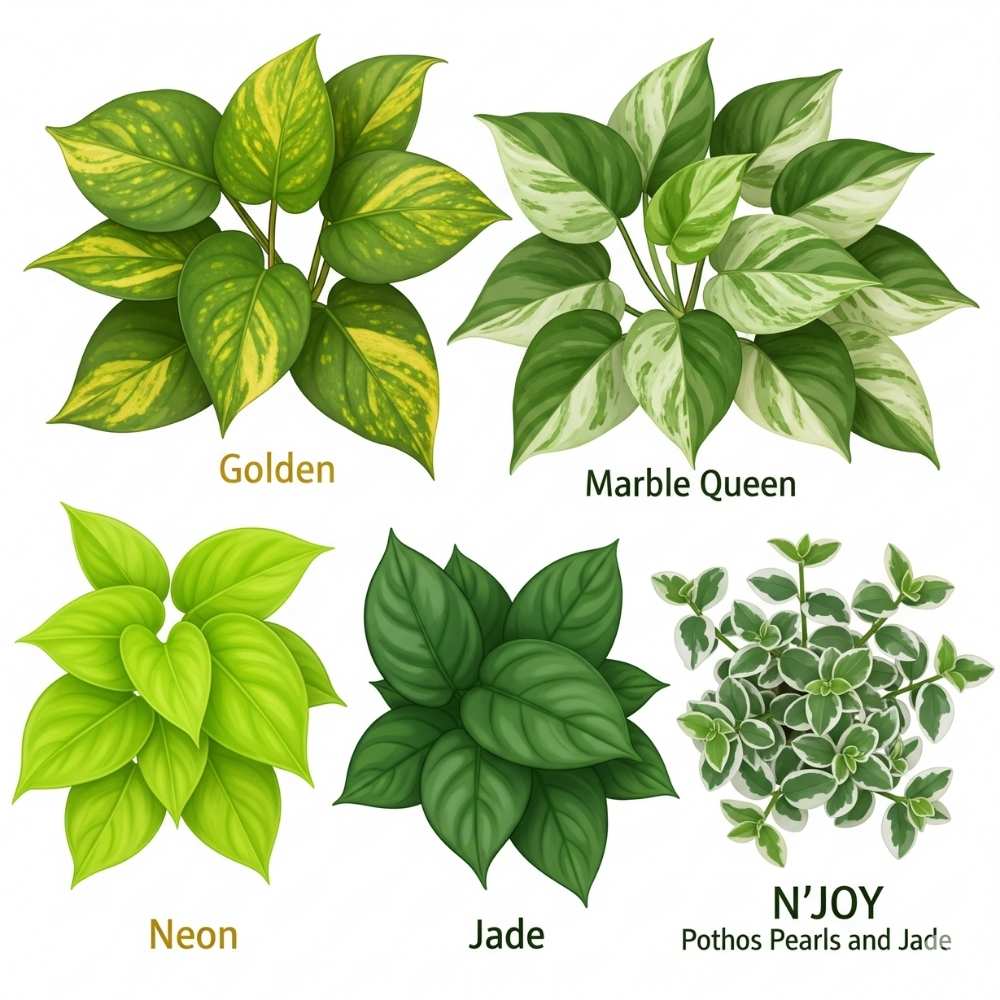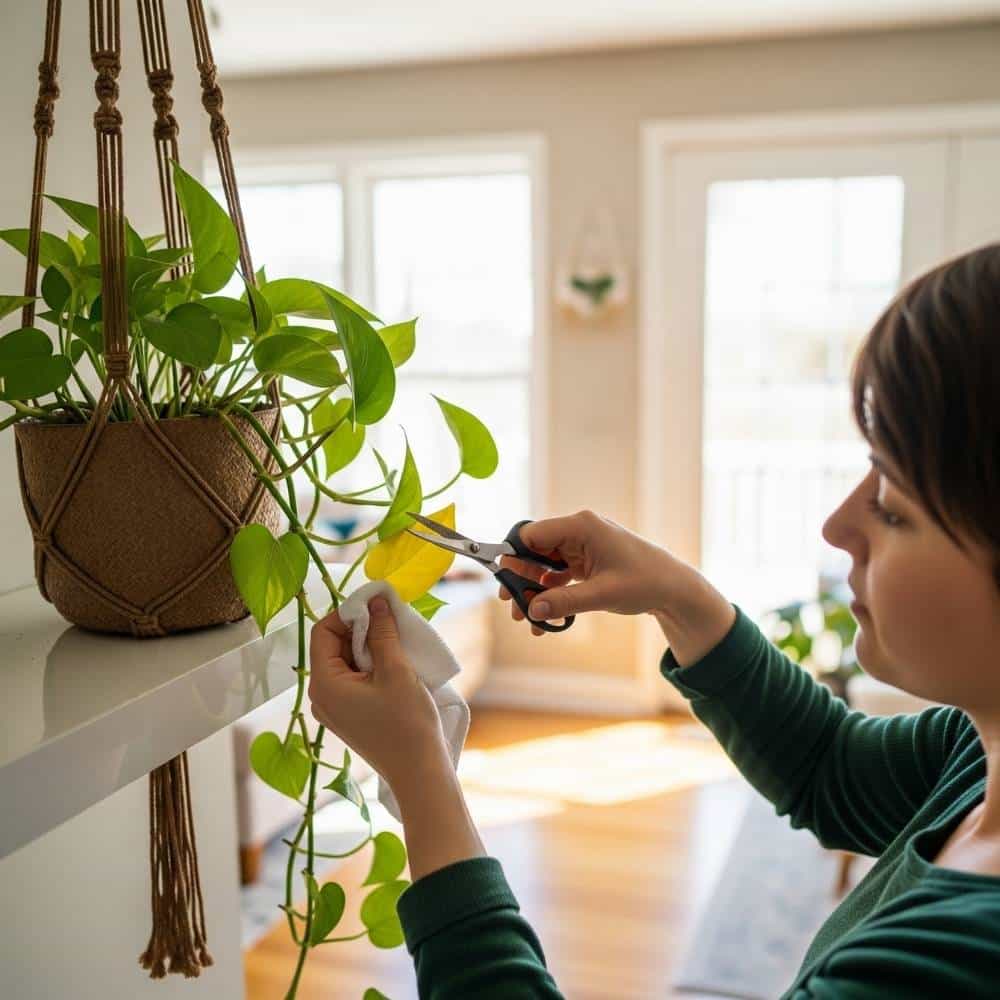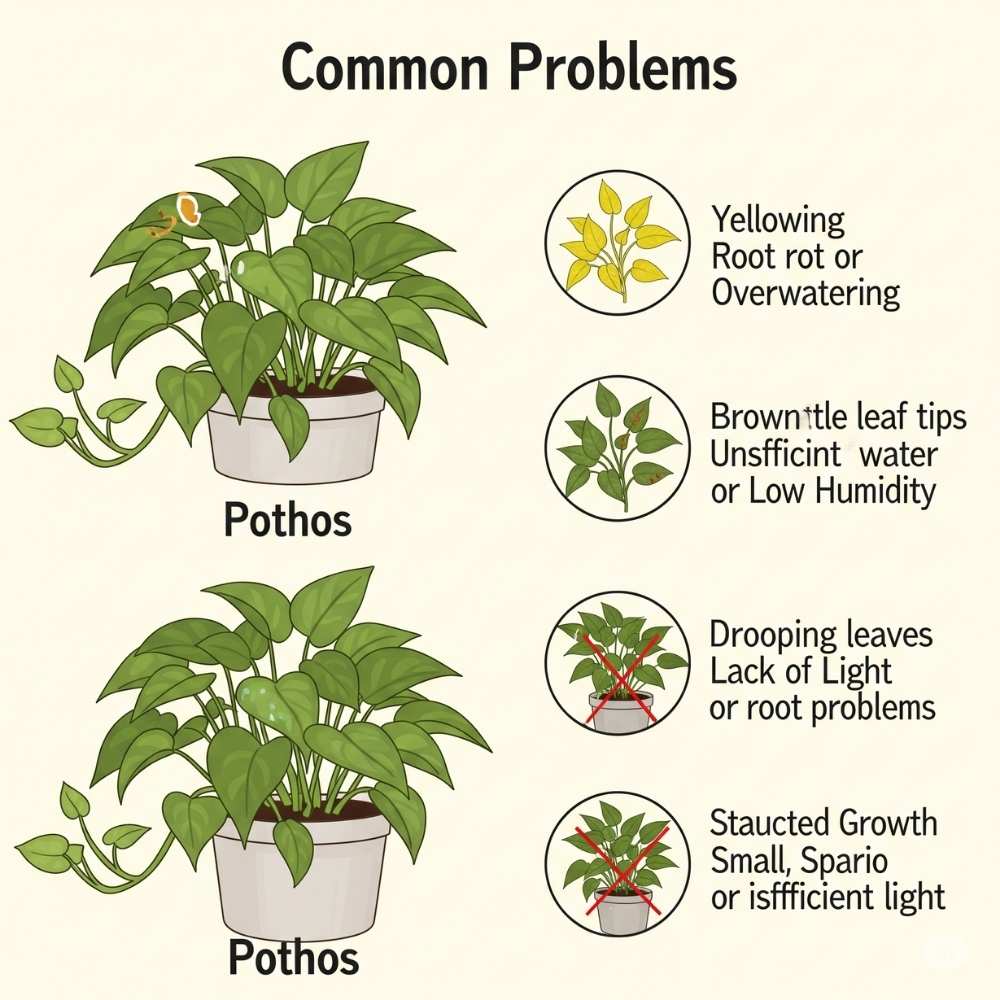Pothos Plant:
Ever wanted a plant that’s basically a green waterfall, looks absolutely stunning, and doesn’t demand too much of your time? Say hello to the Pothos plant! This incredible green friend (Epipremnum aureum is its fancy scientific name) is truly one of the most popular houseplants, and for very good reason. It’s often affectionately known as Devil’s Ivy. This nickname isn’t for any mischievous qualities, but rather a testament to its incredible toughness and resilience, as it remains green even in less-than-ideal conditions.

Hailing from the lush tropical islands of the Pacific, Pothos brings a touch of vibrant greenery and easy-going charm to any home. Whether you’re a complete plant beginner or a seasoned pro, you’ll love how adaptable and rewarding this plant is. Ready to discover why so many people adore this trailing beauty? Let’s dive in!
What Makes a Pothos Plant So Unique? Its Trailing Vines and Heart-Shaped Leaves
When you look at a Pothos, you’ll immediately fall for its beautiful, often glossy, heart-shaped leaves. They pop out along long, trailing vines that can grow incredibly long, making them perfect for draping over shelves or cascading from hanging baskets. These leaves can be a solid vibrant green, or they might have lovely splashes and streaks of yellow, white, or lime green, depending on the type. The Pothos also has little “aerial roots” that help it climb in nature, and you might spot them peeking out from the vines!
Where Do Pothos Plant Come From? Island Roots in the Tropics
Your Pothos plant’s ancestors originally come from the beautiful tropical islands of the Solomon Islands in French Polynesia. Imagine lush rainforests where these plants climb up trees, seeking out bits of sunlight, or spread happily as ground cover. This tropical island heritage explains why Pothos plants are so wonderfully adaptable to different light levels and incredibly forgiving if you forget to water them now and then. They’re built to be tough!
What Are Its Other Names? “Devil’s Ivy” and Why It’s So Tough
The most famous nickname for Pothos is “Devil’s Ivy.” This name isn’t scary at all; it actually highlights just how resilient this plant is! It’s because Pothos is notoriously hard to kill and its leaves tend to stay green even when it’s kept in really dark conditions that most plants wouldn’t tolerate. It truly defies the odds, just like a little green devil!
What Kinds of Pothos Plants Are There?
While all Pothos plants share that lovely heart-shaped leaf, they come in a surprising array of colors and patterns, making them even more fun to collect!

Popular Pothos Varieties
- ‘Golden’ Pothos: This is the classic! It has vibrant green leaves splashed with cheerful yellow or golden variegation. It’s super common and super easy.
- ‘Marble Queen’ Pothos: A real showstopper with stunning green leaves heavily marbled with creamy white or light yellow. To maintain its lovely white patterns, the plant requires slightly more light.
- ‘Neon’ Pothos: Prepare for a pop of color! This variety has brilliant, almost electric, lime-green leaves that truly glow. It’s a favorite for adding a bright, modern touch.
- ‘Jade’ Pothos: The ‘Jade’ Pothos offers a simple yet elegant aesthetic, characterized by its solid, unvariegated dark green leaves. It’s incredibly hardy and looks beautifully lush.
- ***’N’Joy’ / ‘Pothos Pearls and Jade’***: These types have smaller, crisp green leaves with very distinct, clean white or silvery-white edges. They present a refined and delicate appearance.
Leaf Looks: Colors, Patterns, and Shapes
The beauty of Pothos plants really shines in their leaves. You’ll find splashes, streaks, or big blocks of white, cream, yellow, or lime green against the main green. Some leaves are mostly green, others are almost entirely variegated! But no matter the color or pattern, they almost always keep that charming heart shape that makes them so recognizable.
Growth Habits: Trailing, Climbing, or Cascading
One of the best things about Pothos is its versatile growth habit. You can let its long vines happily trail from a hanging basket, elegantly cascade down from a high shelf, or even train it to climb up a moss pole or trellis, giving it a more upright, jungle-like look. It’s whatever you want it to be!
How Do You Take Care of Your Pothos Plant?
Here’s the fantastic news: caring for a Pothos is genuinely one of the easiest tasks in the plant world! They’re incredibly forgiving and adaptable.

Lighting Needs: Adaptable, But Bright, Indirect Conditions Are Preferred
Your Pothos is super flexible when it comes to light. It can definitely tolerate low light conditions, which is why it’s a popular choice for offices or rooms that don’t get much sun. However, for it to truly thrive and keep those beautiful variegated patterns vibrant, it really prefers bright, indirect light. Think of a spot near a window that gets plenty of brightness but no harsh direct sun beating down on its leaves – that can cause sunburn! If your variegated Pothos starts looking plain green, it might be telling you it needs more light.
Effective Watering: Let the Soil Dry Slightly
For Pothos, a fundamental principle is to ensure the upper 2 inches (approximately 5 cm) of soil dries out fully before its next watering. Pothos plants don’t like soggy roots, and overwatering is the most common reason they get unhappy. When you do water, do it thoroughly until water drains out the bottom, then wait until the soil is dry again before the next drink. You can water even less frequently during the cooler, darker winter months.
Cozy Temperatures and Average Humidity, Please!
Pothos plants are happy in average room temperatures, typically between 65-80°F (18-27°C). They’re quite relaxed about humidity too; average indoor humidity is perfectly fine for them, so you usually don’t need to mist or use a humidifier. Just make sure to keep them away from cold drafts from windows or air conditioners, especially in winter.
Choosing the Right Soil and Pot: Good Drainage is a Must!
Since they don’t like wet roots, your Pothos needs well-draining potting mix. A standard indoor potting mix works great, but if you want to be extra safe, you can mix in some perlite or chunky orchid bark to make it even airier. And, as with almost all plants, make sure your pot has drainage holes! Pothos can grow quite vigorously, so you might need to repot them every 1-2 years when they become root-bound, usually in the spring.
Feeding Your Pothos Plant: Light Meals During Growing Season
Pothos plants aren’t super hungry! You only need to fertilize them during their active growing season (spring and summer). A balanced liquid houseplant fertilizer, diluted to half strength, once a month is usually plenty. You can skip fertilizing completely during the fall and winter months.
What Are Common Problems with Pothos Plants and How to Fix Them?
Even though Pothos are super tough, they can sometimes show you if something isn’t quite right. Here’s what to look for:

Yellowing Leaves: Often Overwatering
When your Pothos’s leaves start to yellow, particularly those closer to the base, it’s frequently an indicator of overwatering. The soil is staying too wet, and the roots aren’t happy.
- The Fix: Allow the soil to dry out more thoroughly between waterings. If the soil is consistently soggy, you might need to inspect for root rot.
Brown/Crispy Leaves or Tips: Usually Underwatering or Low Humidity
If the leaves feel crispy or have brown tips/edges, it usually means your Pothos is either a bit thirsty (you’ve let the soil dry out for too long) or the air is too dry (low humidity).
- The Fix: Adjust your watering schedule to be a bit more consistent, or if your home is very dry, an occasional misting might help (though they don’t need high humidity, extreme dryness can show).
Leggy Growth with Small Leaves: Not Enough Light
If your Pothos vines are looking long and sparse with small leaves that are far apart, it’s telling you it needs more light. The plant is stretching to find brightness!
- The Fix: To address this, move your plant to a location with brighter, indirect light. You can also prune any leggy sections to promote fuller, bushier growth.
Drooping Leaves: Thirsty (or Overwatered)
Pothos plants are great at communicating! If their leaves look droopy and sad, they’re usually thirsty. However, if you see persistent drooping combined with soggy soil, it can also signal overwatering and root rot.
- The Fix: Feel the soil. If it’s dry, water it thoroughly. If the soil is wet, allow it to dry out more before watering again.
Pests: Watch Out for Mealybugs and Spider Mites
Pothos are pretty pest-resistant, but occasionally, you might spot common houseplant pests like mealybugs (look for fuzzy white spots) or spider mites (tiny webs).
- The Fix: Regularly check your plant. If you find pests, wipe them off with a damp cloth or cotton swab dipped in rubbing alcohol. For more persistent issues, consider using insecticidal soap or neem oil.
Root Rot: The Silent Killer
This serious problem is caused by consistently soggy soil, leading to the roots literally rotting away.
- The Fix: Prevention is key – always ensure excellent drainage and let the soil dry out between waterings. If you suspect root rot (indicated by mushy stems or a foul smell), you might need to repot the plant into fresh, dry soil after trimming away any unhealthy roots.
Is the Pothos Plant Toxic? Safety for Pets
This is a really important question for pet parents! Please know that Pothos plants are considered mildly toxic if ingested. Like many other popular houseplants (such as Monsteras and ZZ Plants), they contain little crystals called calcium oxalates.
If your cats, dogs, or other pets chew on a Pothos, these crystals can cause irritation. You might see symptoms like:
- Oral pain and irritation: They might paw at their mouth or drool more than usual.
- Vomiting: Especially if they’ve eaten a noticeable amount.
- Trouble swallowing: Due to irritation in the mouth and throat.
While usually not life-threatening, it can be uncomfortable for your furry friends. So, it’s highly recommended to keep Pothos plants out of reach of curious pets and small children. Place them in hanging baskets or on high shelves. If you think your pet has eaten any part of a Pothos and shows symptoms, it’s always best to contact your veterinarian right away for advice.
Pothos Plant for Your Home Decor: Versatility and Lush Greenery
The Pothos plant is an absolute dream for decorating! Its versatile growth and beautiful foliage make it a go-to for adding greenery to any space:
Perfect for Hanging Baskets and High Shelves
With its long, trailing vines, Pothos is the ultimate plant for hanging baskets or placing on high shelves. It creates a beautiful cascading effect that adds depth and life to your room.
Adding Greenery to Any Corner, Even Dim Ones
Thanks to its amazing tolerance for lower light, you can pretty much put a Pothos anywhere you want a splash of green! It’s fantastic for bringing life to those tricky spots that don’t get much sun.
Great for Styling and Creating Green Walls
Beyond just trailing, you can also train Pothos vines to climb up walls or around windows using small clips or hooks, creating your very own living green art! It’s a wonderful way to add vertical interest.
A Natural Air Purifier
Beyond its beauty, the Pothos is also a fantastic air purifier! It was famously part of NASA’s Clean Air Study and is known for its ability to filter out common indoor toxins like formaldehyde, benzene, and xylene from the air. So, it’s not just pretty – it’s actually working to make your home a healthier place to breathe.
The Charm of Pothos Plants: Easy-Going, Beautiful, and Beneficial
The Pothos plant truly embodies the best of indoor gardening. It offers an unbeatable combination of effortless care, stunning beauty, incredible versatility, and tangible air-purifying benefits. Whether you’re a busy bee, just starting your plant journey, or simply looking for a reliable and gorgeous green companion, the Pothos is a perfect choice. It’s a reminder that sometimes the most beautiful things are also the easiest to love!
Frequently Asked Questions (FAQ) About Pothos Plants
Still have some questions about your wonderful Pothos? Here are some common ones that might help you out!
Q1: How often should I water my Pothos?
A1: Water your Pothos when the top 2 inches (about 5 cm) of soil feel dry to the touch. This could be anywhere from once a week to once every two weeks, depending on your home’s temperature, light, and humidity. It’s always better to let it dry out a bit than to overwater!
Q2: Why are my Pothos leaves turning yellow?
A2: Yellowing leaves are very often a sign of overwatering. If the soil stays too wet, the roots can’t get enough air and will start to rot. Make sure the soil is drying out between waterings. Occasionally, older lower leaves will yellow naturally as they age, which is normal.
Q3: Can a Pothos plant live in low light?
A3: Yes, Pothos plants are very tolerant of low light conditions, which is why they’re so popular for offices and dim rooms. However, if you have a variegated type (like ‘Marble Queen’ or ‘N’Joy’), it might lose some of its pretty white or yellow patterns and turn greener in very low light. For the best growth and color, bright, indirect light is ideal.
Q4: How do I make my Pothos plant look fuller?
A4: To get a bushier Pothos, you can prune it regularly! Simply snip off the ends of the longest vines right after a leaf node. This encourages the plant to branch out and grow more shoots from the base, making it look much fuller. You can even propagate the cuttings!
Q5: Why are my Pothos Plant leaves small and sparse?
A5: Small, sparse leaves that are far apart on long vines usually mean your Pothos isn’t getting enough light. It’s stretching and putting all its energy into reaching for brightness.
- The Fix: Move it to a spot with brighter, indirect light. You can also prune back the leggy parts to encourage new, healthier growth.
Q6: Can I grow a Pothos Plant in water permanently?
A6: Yes, you absolutely can! Pothos cuttings root very easily in water, and many people choose to keep them growing in water long-term. Just make sure to change the water every week or two to keep it fresh. You might need to add a very diluted liquid fertilizer to the water every month or so for long-term health.
Q7: How fast does a Pothos plant grow?
A7: Pothos plants are known for being fast growers, especially during their active growing season (spring and summer). With good light and proper care, their vines can lengthen quite rapidly, allowing you to enjoy that cascading effect quickly!
Q8: Is the Pothos plant safe for my pets?
A8: No, the Pothos plant is considered mildly toxic if ingested by cats, dogs, and other pets. It contains calcium oxalate crystals that can cause irritation to the mouth, throat, and stomach. It’s best to keep Pothos out of reach of curious pets.
Q9: What’s the best way to propagate a Pothos?
A9: Pothos is incredibly easy to propagate! The simplest way is via stem cuttings. Just cut a section of vine that has at least one node (where a leaf meets the stem), remove any lower leaves, and place it in a glass of water. Roots will usually appear within a few weeks! You can then plant it in soil once the roots are a few inches long.





